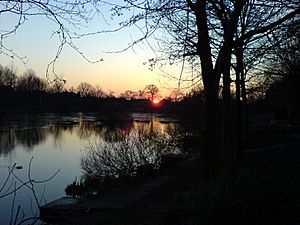Sykes Bleaching Company facts for kids
The Sykes Bleaching Company was a big business that cleaned and whitened cotton fabric. It started in 1792 in Edgeley, near Stockport, in the United Kingdom. Over time, it became one of the largest companies of its kind.
Contents
How it Started
The company was founded by William Sykes in 1792. William had worked with cloth in other towns like Halifax and Manchester.
In November 1792, an advertisement appeared for land in Edgeley, Stockport. It said the land was perfect for a "Bleach Ground" because it had good water sources. It was also close to the busy town of Stockport, where there was a need for cloth cleaners.
William Sykes rented this land and later bought it. He then built his bleach works.
The Old Way of Bleaching
Back then, cleaning cloth was a long process.
- First, cloth was soaked in natural solutions made from ash. This was called "bucking."
- Then, it was washed.
- After that, the cloth was hung out in large fields, called "bleachfields" or "crofts," to dry in the sun and air.
- Next, it was dipped in buttermilk, which was called "souring."
- Finally, it was washed, stretched, and dried one last time.
This whole process could take up to eight months! Because the cloth was left outside, a watchman had to guard Sykes's fields at night to prevent theft. Stealing cloth from a field could even lead to serious punishment.
Weavers from nearby towns brought their cloth to Sykes's works. The cleaned cloth was then sold to merchants in Manchester and London. Some early customers were famous names like Oldknow and Cadbury. The company even had customers as far away as Boston, Massachusetts in America and Messina in Italy.
Changes and Growth
When William Sykes moved to Stockport, there were not many trees. Wood was important for drying the cloth, so he planted many trees. This land later became part of Alexandra Park. He also built a large house called Edgeley House, where his family lived for many years.
At first, the works used water power to run its machines. But in 1803, they added a 12-horsepower steam engine. By 1804, new chemical methods using calcium hypochlorite were introduced. These chemicals meant the cloth no longer needed to be laid out in fields, but the process still needed a lot of water.
Growing Bigger
Edmund Sykes took over the business from his father, William, before 1809. In 1812, a group of workers called Luddites attacked the works. They even threatened the Sykes family at their home until soldiers arrived and stopped them.
Edmund Sykes used companies like Pickfords to deliver the cleaned cloth. In 1820, Edmund's younger brother, Richard, joined the business. The company was then known as E & R Sykes.
In 1828, Edmund Sykes left the business. Richard Sykes then took full charge. Under his leadership, the company in Edgeley grew very quickly. Richard worked hard to make the factory more modern. They dug new wells, including one called the "Silver Well." By 1830, these wells had quadrupled their water supply. They also built large reservoirs. These water projects were very helpful to local people during dry periods.
Richard Sykes was also involved in public life. He was a Justice of the Peace for Cheshire and served as Mayor of Stockport from 1850 to 1851. He was also an active member of the Society of Bleachers. The Sykes company was very interested in using science to improve bleaching. They even hired John Dalton, a famous chemist, to advise them on their water quality.
Richard Sykes passed away in 1876. His son, Thomas Hardcastle Sykes, then took over the business.
The Bleachers Association
Sykes became a limited company in 1892. This meant it was owned by shareholders, but the Sykes family, including Thomas Sykes's son, Alan (known as Jack), still managed it.
However, there was a lot of competition among bleaching companies. This made it hard for businesses to invest in new technology. To solve this, the Bleacher's Association was formed in June 1900. This new group brought together about 60 different companies that bleached and finished cotton goods. Most of these were in Lancashire, but some were in Scotland and Northern Ireland.
Jack Sykes became one of the first directors of the Association. After his father, Thomas Sykes, retired, Jack continued to manage the Edgeley works. He followed the Association's careful financial plans.
After it was formed, the Bleacher's Association kept buying up other competing companies. They also made agreements with other large textile groups. Between 1901 and 1910, they bought nine more works. After World War I, they bought another 21 works.
In 1926, the Association opened its new main office, Blackfriars House. Jack Sykes even wrote a book about the bleaching industry to celebrate the Association's 25th anniversary.
However, the success of the Bleacher's Association could not last forever. Even though they kept profits high, the amount of trade was going down. Prices were lowered in 1928, and after that, the business faced big challenges as British textile exports continued to decline.


